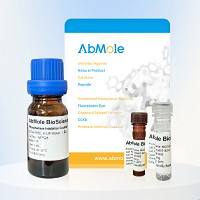All AbMole products are for research use only, cannot be used for human consumption.

Sulfatase (from Helix pomatia) facilitates the synthesis of thiohydroximates. It causes the hydrolysis of β-naphthyl sulfate much faster than a-naphthyl sulfate and possesses regiospecificity in the hydrolysis of ortho and para substituted phenyl sulfates.
Sulfonation and sulfation are catalyzed by various sulfotransferases. In turn, desulfonation and desulfation occur via the action of sulfatase. Sulfonation and sulfation are important processes in the metabolism of compounds such as hormones, neurotransmitters, and drugs.
Helix pomatia sulfatase can be used for deconjugation studies of various compounds, including:
Environmental contaminants, such as bisphenol A
Hirudin
Vitamin E metabolites
β-adrenoreceptor agonists
Lignans from carob germ and carob seed
Unit definition: One unit will hydrolyze 1.0 µmole of p-nitrocatechol sulfate per hour at pH 5.0 at 37 °C, in a 30-minute assay.
Sulfatase activity: ≥10,000 units/g solid
Enzyme Commission (EC) Number: 3.1.6.1
Synonyms: Aryl-sulfatase, Aryl-sulfate sulfohydrolase, Phenolsulfatase
| CAS Number | 9016-17-5 |
| Form | Powder |
| Solubility (25°C) | Preparation of solutions of this sulfatase product at 100 units/mL in 200 mM sodium acetate buffer with 20 mM saccharic acid 1,4-lactone. |
| Storage | -20°C |
[5] Frederick C Kauffman. Drug Metab Rev. Sulfonation in pharmacology and toxicology
| Related Enzymes & Coenzymes Products |
|---|
| Pepsin (porcine stomach mucose)
Pepsin is the major pig and human gastric proteases, it is a pepsin-like minor gastric proteolytic enzymes. Pepsin is a commonly used digestive enzyme for immunohistochemical procedures. |
| Creatine phosphokinase (rabbit muscle)
Creatine phosphokinase is an organ-specific enzyme that is mainly found in skeletal muscle, cardiac muscle, and brain tissue. Creatine phosphokinase (CPK) catalyzes the reversible reaction of creatine and ATP to form phosphocreatine and ADP. Creatine phosphokinase is a key enzyme for maintaining a constant ATP/ADP ratio during rapid energy turnover. |
| Glucose-6-phosphate dehydrogenase
Glucose-6-phosphate dehydrogenase is used to convert p-glucose-6-phosphate to p-glucono-d-lactone-6-phosphate in presence of NADP+ or NAD+. Glucose-6-phosphate dehydrogenase can be used along with hexokinase in the determination of glucose from mice liver samples. |
| Glucose isomerase
Glucose isomerase can catalyze the reversible isomerization of D-glucose and D-xylose into D-fructose and D-xylulose, respectively. |
| β-Galactosidase (from Aspergillus oryzae)
β-Galactosidase acts on the terminal β-D-galactosyl moieties of disaccharides, glycoconjugates, and polysaccharides. It is useful in mediating transglycosylation reactions such as the synthesis of galactooligosaccharides (GOS). β-Galactosidases might be used for glycobiological and biotechnological applications. β-galactosidase cleaves lactose into its monosaccharide components, glucose and galactose. It also catalyses the transglycosylation of glucose into allolactose, the inducer of β-galactosidase, in a feedback loop. |
All AbMole products are for research use only, cannot be used for human consumption or veterinary use. We do not provide products or services to individuals. Please comply with the intended use and do not use AbMole products for any other purpose.


Products are for research use only. Not for human use. We do not sell to patients.
© Copyright 2010-2024 AbMole BioScience. All Rights Reserved.
